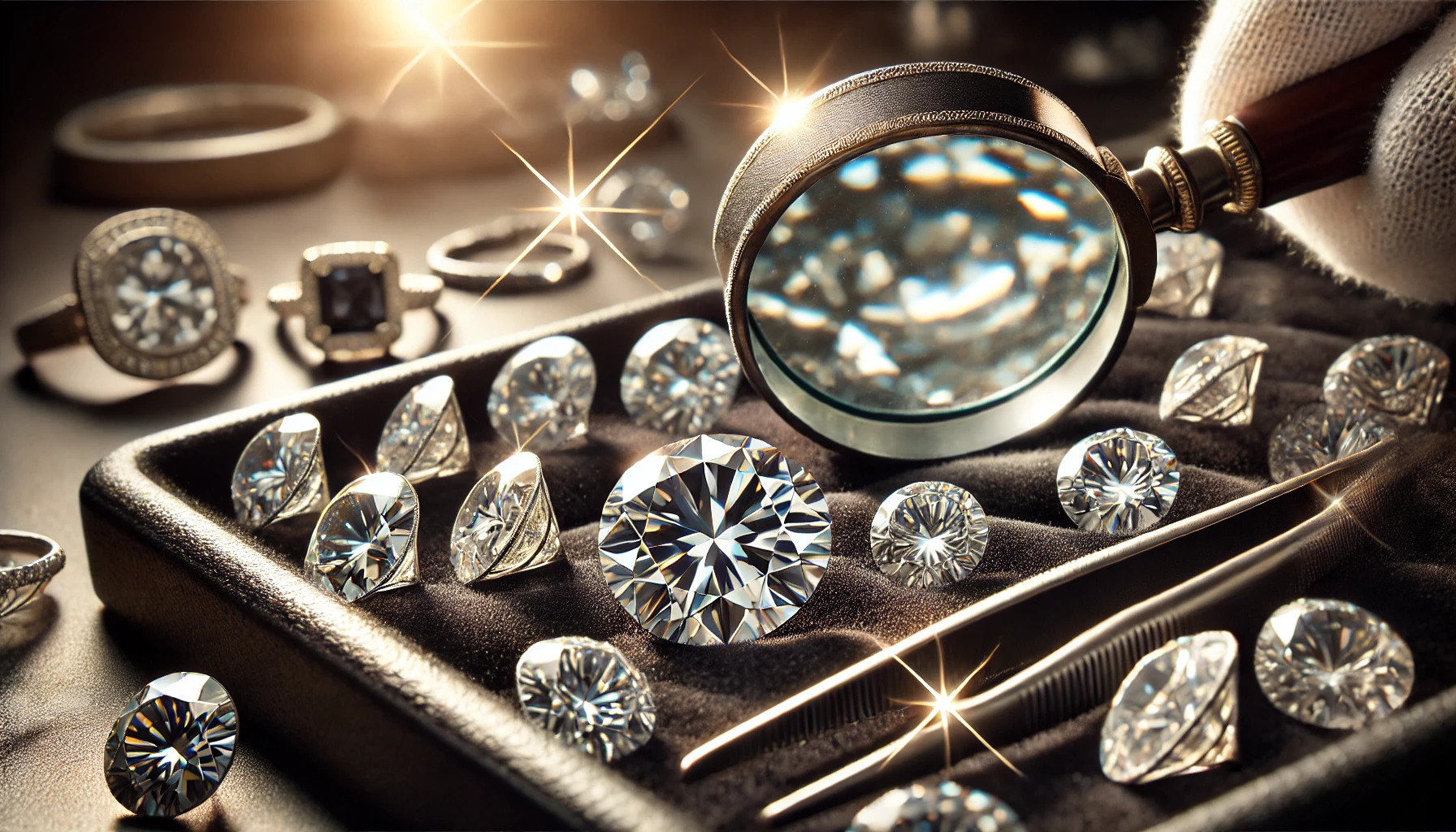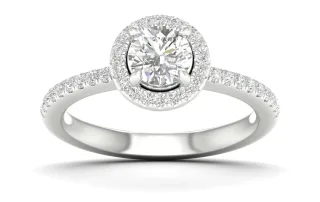
When you’re shopping for a diamond, one of the most important aspects to understand is how diamonds are graded. Whether you’re browsing the selections at Bijouterie Bserkos or exploring other jewelers, knowing the grading process can help you make an informed decision. But what exactly goes into the grading of diamonds, and how can you tell if one diamond is better than another? This guide will take you through the intricate process of diamond grading, focusing on the four key factors known as the “Four Cs.”
The Four Cs of Diamond Grading
Diamonds are primarily graded based on four key characteristics, commonly referred to as the Four Cs: Carat Weight, Cut, Clarity, and Color. Each of these factors plays a role in determining the value, beauty, and desirability of a diamond. Let’s break them down one by one.
1. Carat Weight: The Size of the Diamond
The term “carat” refers to the weight of the diamond. This is often the most well-known aspect of diamond grading because carat weight is directly tied to the size of the diamond. One carat equals 200 milligrams or 0.2 grams.
It’s important to note that larger diamonds tend to be more expensive because they are rarer. However, two diamonds of equal carat weight can still have very different values depending on their other characteristics like cut, clarity, and color. For example, a poorly cut diamond might appear smaller than its carat weight suggests because it doesn’t reflect light well.
2. Cut: The Diamond’s Sparkle and Brilliance
Cut refers to how well a diamond has been shaped and faceted, and it has the most significant impact on a diamond’s overall appearance. Even if a diamond has perfect clarity and color, if the cut is poor, the diamond will lack brilliance.
Cut quality is graded from Excellent to Poor, based on how well the diamond reflects light. A well-cut diamond will sparkle and reflect light in an attractive way, while a poorly cut diamond will appear dull. A common misconception is that the cut refers to the diamond’s shape (such as round, princess, or oval), but it actually refers to the precision with which the diamond’s facets are aligned to produce light performance.

3. Clarity: The Purity of the Diamond
Clarity measures the internal and external flaws, also called inclusions and blemishes, that can be found in a diamond. The fewer inclusions a diamond has, the higher its clarity grade. Clarity is graded on a scale from Flawless (FL) to Included (I1, I2, I3).
- Flawless (FL): No inclusions or blemishes visible under 10x magnification.
- Internally Flawless (IF): No internal inclusions but may have small external blemishes.
- Very Very Slightly Included (VVS1, VVS2): Inclusions that are extremely difficult to see under 10x magnification.
- Very Slightly Included (VS1, VS2): Inclusions that are difficult to see under 10x magnification.
- Slightly Included (SI1, SI2): Inclusions that are visible under 10x magnification but not to the naked eye.
- Included (I1, I2, I3): Inclusions that are visible to the naked eye and may affect the diamond’s durability.
Even though inclusions may lower the value of a diamond, many inclusions are microscopic and do not impact the diamond’s beauty to the naked eye.
4. Color: The Diamond’s Natural Hue
Color in diamonds refers to the presence or absence of color. The most valuable diamonds are colorless, allowing light to pass through them and be dispersed into a rainbow of colors. The color of diamonds is graded on a scale from D (colorless) to Z (light yellow or brown).
- D-F: Colorless. The most rare and valuable diamonds.
- G-J: Near colorless. These diamonds may have a slight hint of color that is only noticeable when compared to higher color grades.
- K-M: Faint yellow. A subtle yellow or brown tint is visible.
- N-Z: Noticeable yellow or brown tint.
The closer a diamond is to colorless, the higher its value. However, some fancy colored diamonds, such as pink, blue, or green diamonds, are exceptions to this rule and are prized for their unique hues.
Grading Laboratories: Who Grades the Diamonds?
Diamonds are graded by professional laboratories that specialize in assessing and certifying the Four Cs. The most reputable of these laboratories include:
- Gemological Institute of America (GIA): One of the most respected and widely used grading institutions.
- American Gem Society (AGS): Known for its strict grading standards, particularly with diamond cuts.
- International Gemological Institute (IGI): Popular for grading diamonds in various markets, including Europe and Asia.
Each diamond that is graded receives a certificate or grading report that details its characteristics. When buying a diamond, especially at respected jewelers like Bijouterie Bserkos, always ask for the grading certificate to verify the diamond’s authenticity and quality.
How the Grading Process Works
Once a diamond is submitted to a grading laboratory, it goes through a detailed examination process. First, gemologists inspect the diamond under specialized lighting conditions to assess its color. They then use magnification and other tools to evaluate clarity, looking for any inclusions or blemishes.
To evaluate cut, the diamond’s proportions are measured using specialized instruments. Finally, the diamond’s carat weight is recorded. All of these elements are combined into a report, which gives the diamond its overall grade.
Why Diamond Grading Matters
Diamond grading is essential because it helps both buyers and sellers determine a diamond’s value. Without a grading system, it would be difficult to compare diamonds and ensure that you’re getting a fair price.
For example, two diamonds may look nearly identical to the untrained eye, but one could have a better cut or clarity, making it significantly more valuable. By understanding the Four Cs and reviewing a diamond’s grading report, you can make an informed decision and choose the diamond that’s right for you.
The Impact of Diamond Certification on Value
A diamond’s certification can have a huge impact on its value. A certified diamond is one that has been inspected and graded by a reputable laboratory, while a non-certified diamond has not undergone the same level of scrutiny.
At Bijouterie Bserkos, certified diamonds are often preferred because they come with proof of their quality. Non-certified diamonds can still be beautiful, but their value might not be as high because they lack the official grading report that guarantees their characteristics.
Other Factors That Can Influence Diamond Value
While the Four Cs are the main factors that determine a diamond’s value, there are other considerations as well. Diamond fluorescence, for example, can cause a diamond to glow under UV light, which may impact its price. Additionally, the shape of the diamond (round, oval, pear, etc.) can affect how light is reflected and how the diamond is perceived.
Conclusion: Choose Wisely with Bijouterie Bserkos
Understanding how diamonds are graded is crucial if you’re in the market for an engagement ring, a gift, or a personal treat. At Bijouterie Bserkos, you can find a wide range of certified diamonds, ensuring that you get a high-quality stone that matches your budget and desires. By focusing on the Four Cs—Carat Weight, Cut, Clarity, and Color—you can make an informed decision and pick the perfect diamond for any occasion.
Check out our other blogs!
FAQs
1. What is the most important C when buying a diamond?
While all Four Cs are important, many experts believe that cut is the most crucial because it has the biggest impact on the diamond’s brilliance and sparkle.
2. Are diamonds with inclusions bad?
Not necessarily. Many inclusions are so small that they are not visible to the naked eye and don’t affect the beauty of the diamond.
3. Can I trust a non-certified diamond?
It’s always safer to buy a certified diamond, as certification provides proof of the diamond’s quality and authenticity.
4. What is diamond fluorescence?
Fluorescence refers to how a diamond reacts under UV light, sometimes giving off a bluish glow. In some cases, it can affect the diamond’s appearance and value.
5. Does a higher carat mean a better diamond?
Not always. A larger carat weight may make a diamond more expensive, but the overall value depends on the combination of all Four Cs. A smaller diamond with a better cut or clarity could be more valuable than a larger one with inferior qualities.
Latest Posts
Pre‑Owned Luxury Watches in Montreal & Laval — How to Buy with Confidence
Shopping for Pre‑Owned Luxury Watches (a.k.a. used luxury watches) should [...]
Milestone Moments: An Anniversary Jewelry Gift Guide for Every Milestone
Looking for the perfect anniversary jewelry gift? This anniversary jewelry [...]
Jewelry Care 101: Easy Tips to Keep Your Treasures Sparkling
Your jewelry isn’t just an accessory—it’s a reflection of personal [...]
From Office to Evening: Transition Your Jewelry from Workday to Night Out
In a fast-paced city like Laval, where days at the [...]
Laval Love Stories: 5 Best Proposal Spots (and the Perfect Rings to Match)
When it comes to unforgettable love stories, it’s all about [...]
Lab-Grown vs. Natural Diamonds: What You Need to Know
If you're shopping for a diamond in Laval, you may [...]








